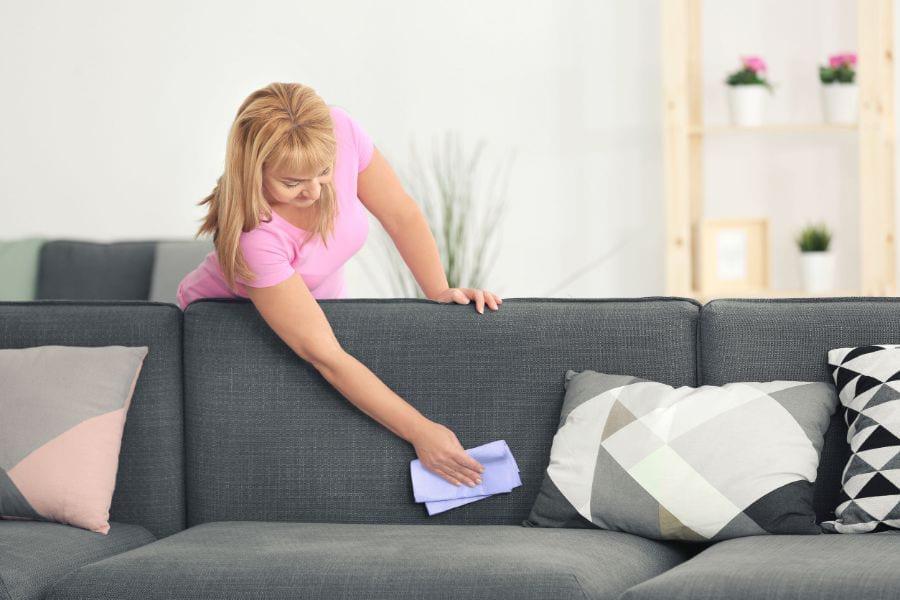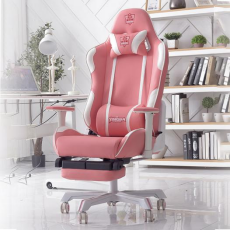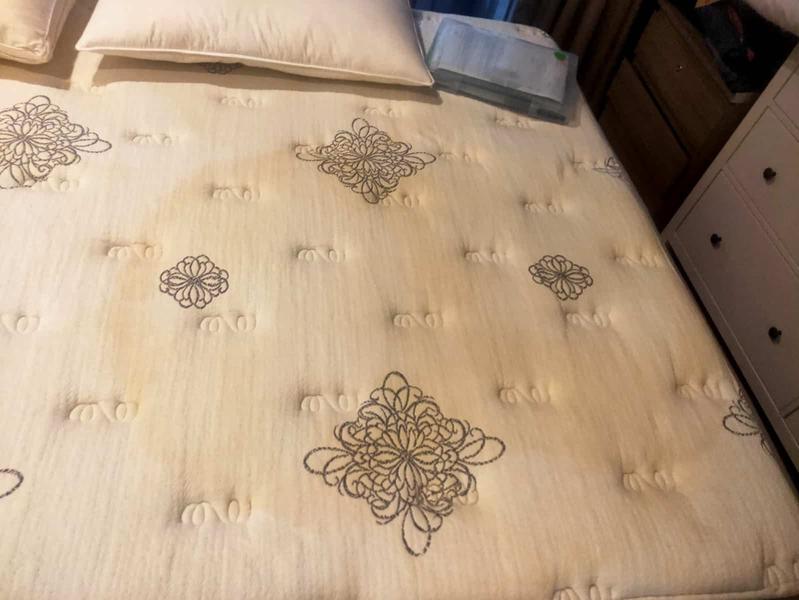How to Clean a Fabric Couch
Your couch is the centerpiece to the most used room in the house. Not only does it get its fair share of wear and tear, but it’s one of the most challenging items to clean. You can’t just toss your sofa into the washing machine when it needs a good scrubbing, so knowing how to clean a fabric couch properly is essential for maintaining the cleanliness of your home.
Begin with a fantastic homemade fabric sofa cleaner. While not all couches respond to ingredients the same way, knowing which recipe is right for the material you’re cleaning makes the difference between washing and damaging your furniture.
Equally, understanding how to clean a fabric sofa requires the use of some effective cleaning products and supplies, all of which are relatively accessible in the average household. If you’re ready to refresh the look of your fabric couch and eliminate stains, then let these recipes and tips guide the way!
tb1234tb1234Table Of ContentsSimple Tips to Clean a Fabric Sofa
You may be surprised to know that there are many things to think about when it comes to cleaning your sofa. Most notably is what material the furniture consists of, which ultimately impacts the cleaners you use. Selecting ingredients and supplies to clean a couch that match the color and texture of the fabric is essential, so always check the manufacturer’s tag before starting.
If you’re lucky enough to have removable covers on the couch or the cushions, you can always remove them and throw them in the wash. Washing couch covers is easy and a great way to take care of surface stains and odors.
Vacuum Your Sofa First
Before using any fancy cleaning solutions, start with vacuuming. Clearing away any dirt and debris ahead of time provides you with a fresh, clean space to work with before applying soaps or a stain remover. The last thing you want to do is work the grit and grime further into the sofa, so this first step is critical.
Remove dog hair from a couch, or cat hair, before cleaning so that you don’t spread it around with the cleaner. Connect the upholstery attachment that comes with your vacuum cleaner to carefully remove all loose particles. Use a soft brush attachment to loosen dirt and pet hair, but don’t forget to get deep into cracks and crevices of the couch, as well.
This is also a great way to regularly clean and maintain the look of your furniture in between deep cleanings. Vacuum the sofa once a week, or whenever you vacuum the rest of the room.
Check the Label
After completely removing all the dirt particles from within the nooks and crannies of your couch cushions, the next thing you want to check is the recommended cleaning method. These instructions appear on the manufacturer’s tag, which uses a label of either a “W,” “S,” “WS,” or an “X.”
If your couch has an “X” label, then you’ve already done all you can as far as cleaning on your own. Only clean sofas with the “X” label professionally.For all other labels, you still have some wiggle room when it comes to your taking care of the couch fabric.
A “W” label means a water-based cleaner is required, while an “S” label demands the use of a solvent-based cleaner or a dry cleaning agent. The “WS” tag means you can use either of these two solutions to clean upholstery.
How to Clean a Fabric Couch with Dish Soap
The best way to clean fabric couch by hand, especially if you have a sofa with a “W” label, is to use a gentle cleaner like dish soap and warm water. The degreasing properties in soap safely remove most oils and grime from the sofa.

Too much moisture when cleaning damages the texture of the couch’s interior and potentially opens it up to developing mildew. To prevent this issue from happening, do not soak the furniture with the mixture when cleaning. Use as little of the solution as possible when tackling stains.
tb1234Gentle Couch Cleaning Detergent
tb1234To make this simple but quite effective home upholstery cleaner, mix the ingredients in a small bucket until the soap gets nice and foamy. A fabric brush is an excellent way to scrub and clean along the surface of the couch while also fluffing up the fibers.
If you don’t have a fabric brush for scrubbing the surface of the couch, then a microfiber cloth or a clean cloth free of lint also works. Scrub the fabric until you’ve cleaned the entire area, then leave it to air dry.
Take care of washing throw pillows and cushions the same way. Check the label on the pillows as it may be acceptable to clean them in the washing machine or at least remove the cover and toss it in the washer.
Homemade Fabric Sofa Cleaner with Vinegar
Another sofa fabric cleaning solution safe to use on most materials, even your leather couch, is vinegar. Vinegar acts as a powerful disinfectant and removes the majority of stains, as well. In fact, besides using hydrogen peroxide, it’s the best way to remove tough stains like red wine, and it doesn’t bleach the fabric.
tb1234DIY Vinegar Fabric Cleaner
tb1234To disinfect a fabric couch and remove unsightly stains at the same time, use this easy home remedy. When using, mix the ingredients in a spray bottle and shake well.
Do not spray the couch directly. Instead, spray the cleaning cloth with the mixture first, then wipe the damp cloth along the surface of the fabric. Let it air dry when finished.
Freshen and Deodorize Fabric with Baking Soda
A great way to clean your couch without subjecting it to potential water damage or cleaners is to use baking soda. Cleaning a fabric couch with baking soda effectively absorbs odors while also soaking up oily stains on the fabric. Baking soda works on most materials, including challenging fabrics like leather, suede, and microfiber.
This cleaning powder is an ideal natural fabric freshener and deodorizer that costs just pennies. To use this solution for cleaning couch cushions and the sofa itself, remove the cushions first. Sprinkle the baking soda across the sofa and on one side of the cushions and leave it there for approximately 30 minutes.
For particularly musty couches, allow the baking soda to sit overnight. Vacuum up the powder in the morning or after enough time has passed. For the cushions, vacuum one side to suck up the baking soda and then repeat the process on the other side.
Try this remedy for removing slime from a microfiber sofa, too. You may be pleasantly surprised by the excellent results.
How to Clean a Fabric Sofa with a Steam Cleaner
Another option available for couches with the “W” or “WS” label is to use a steam cleaner. Just as with the other cleaning techniques, vacuum first and clear away all debris. Before treating the entire couch, do a spot test first to ensure the carpet cleaner does not ruin the fabric.
Use the attachments on the machine to treat every inch of the surface on the couch. If your upholstery cleaner uses a microfiber cloth at the end, replace it every so often to prevent spreading dirt from one end of the sofa to the next. Once you’ve finished steam cleaning, dry the couch using a floor fan to speed up the process.
Cleaning Microfiber Couches
When cleaning a microsuede couch, avoid harsh chemical cleaners that cause discoloration, such as acetone or bleach. You also want to avoid using the steam cleaning strategy on these types of fabrics, as they may cause significant water damage.
Instead, providing a gentle cleaning with soap works best, unless you need to remove stains. In that case, rubbing alcohol is one of your best options. It’s also a great way to spot treat a leather sofa with unsightly spots.
Before using, test out the rubbing alcohol on an inconspicuous area of the couch to gauge whether it will bleach the fabric. Once it’s passed the test, simply dab the stain using a cotton ball dipped in alcohol. Rinse clean with a damp cloth when done and leave it to dry.
Dealing with Tough Stains
A stronger variation on the vinegar recipe is to add salt to the mixture. This formula works exceptionally well when cleaning tea stains out of fabrics on the couch. The salt provides additional scrubbing power without subjecting your furniture to harsh abrasive scrubbers.
tb1234Vinegar and Salt Stain Remover
tb1234If using pure vinegar doesn’t work, adding salt to the mixture scrubs away any lingering pieces embedded within the fabric. One way to rub the salt into the sofa after washing with vinegar is by using a soft toothbrush or a dry cloth.
Scrub the area with the salt, then rinse away with clean water on a damp towel. Repeat this process as necessary to remove the stubborn stains.
To remove permanent marker from a fabric sofa, try dabbing the area with a clean cloth and some rubbing alcohol. Treat the stain from the outside in to keep it from spreading. Hairspray may also be effective.
Last Bit of Advice about Cleaning Couches
While we’ve covered most of the information you need to get started, we’ve also provided some additional tips to help you throughout the year. Curious about how often to use these cleaning tips? Then look no further!
How often should I clean my couch?
The ideal time frame for regular cleanings is once a week. This process doesn’t require a full washing of the sofa, just a light brushing with the vacuum cleaner to prevent a buildup of dirt. Deep cleanings are only necessary every six to 12 months.
As for stain treatments, handle those on a case-by-case basis. Do not let stains sit for long periods, however. Clean them up immediately to keep the stain from setting in and ruining the fabric permanently.
Now you have plenty of different ways to tackle the maintenance of your fabric sofa. Whether preparing it for a deep clean, spot treatment, or just a simple brushing, these helpful cleaning tips provide you with all you need to know about how to clean a fabric sofa.
If you found the homemade fabric sofa cleaner recipe of your dreams on our site, then please feel free to share how to clean a fabric couch with everyone you know on Facebook and Pinterest.
Copyright © 2023 furnitureknowledges.com. All rights reserved.







